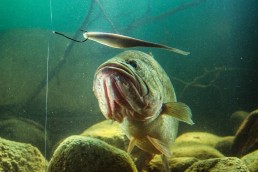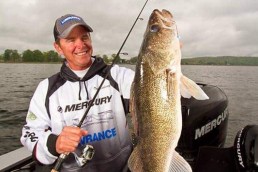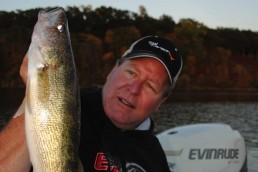Fall Downriver Movements of Walleyes and Smallmouths
SHARE THIS POST
“It’s all downhill from here,” the old saying goes, sounding far more pessimistic than encouraging. Yet that’s not necessarily the case. Especially in fall, in small rivers supporting good walleye and smallmouth populations.
Yes, the water temperature is dropping, and the water’s flowing downhill. But in shallow river sections, not all of the fish are instinctively running upstream to wintering holes below dams. Quite the opposite, in fact!
Small rivers lack huge dams and powerful flows to create deep, expansive tailwaters that attract massive numbers of fish. It makes far more sense (instinct) for bass and walleyes to head downstream to reservoir sections as water temperatures begin cooling. Even if they have to swim a long way to get there, they’ll find exactly what they need to survive a long winter’s icy grip.
Deeper water, reduced current, plenty to eat
To a fish, this sounds like a pretty good fall combo. It’s certainly more attractive than getting trapped for the winter in a 10-, 15- or 20-mile section of river that’s only 3 or 4 feet deep, where fish could easily become encased in thickening ice. Heck, it makes perfect sense to go with the flow until they find safe wintering holes until the spring thaw.
Early-fall transition
Water temperatures between about 55 F and 60 F find smallmouths and walleyes on the move, here today, gone tomorrow. Wearing polarized sunglasses, you just might see groups of 10 or 15 smallies making mad dashes across shallow sandbars along their pathway to deeper haunts. Walleyes likely do the same thing, mainly at night, hopping pool to pool at river bends on their way downstream.
Covering water and casting crankbaits is an ideal strategy for smallies at this time; just keep moving until you locate pods of biters. Check the tops and bottoms of islands where bass may hold temporarily.
If you’re focused on walleyes, be sure to jig the outside bends of the river where they lurk during the day. Six to 10 feet of depth may be sufficient to hold fish.
Mid-fall arrival
Water temperatures below 55 F start seeing hordes of smallmouths entering the top ends of reservoir sections above dams. These reservoirs are seldom large or very deep, but that’s okay. If there’s 18 to 20 feet of water (or more), it’s plenty deep for winter use.
As fish first begin entering the reservoir portion, where the river first widens and the current slackens, they begin to spread out into areas of reduced current or slightly deeper water. Early on, both bass and walleyes are likely to hold atop points and flats, around islands, and in shallow weed beds of, say, 6 to 8 feet in depth. Cranks and spinnerbaits will catch both species, although the odds go to crankbaits for walleyes. Even big ones! Chances are you’ll catch some mighty impressive largemouth bass, too.
Are you enjoying this post?
You can be among the first to get the latest info on where to go, what to use and how to use it!
As more and more fish arrive, some are likely to disperse down into the reservoir itself, with classic points, humps and bends in the old river channel collecting groups of fish. Fact is, they simply can’t all fit in those initial contact areas; there’s not enough space to feed all the arrivals.
Consider this: If all or most of the bass and walleyes in 30 or 40 miles of shallow river habitat all move downstream to these wintering holes, you now have some pretty impressive schooling going on. This is prime time for catching large numbers of big fish of both species.
Mid- to late-fall deepening
As the water temperature cools down below 50 F, you’ll likely see smallmouths begin to drop off the flats, into adjacent deep water. Very importantly, they now use spots with adequate depth to survive the winter, sufficient forage availability, and where the current is slow to negligible. Smallmouths will not fight current when the water gets cold, and may desert formerly good spots in favor of new ones. So you may need to go look for them.
The good news is, when you find them, you may find hundreds of smallies stacked atop each other at the base of a dropoff. Vertically jigging tubes, livebait rigging with chubs, or dropshotting small softbaits all excel for tempting fish at this time. At the beginning of this stage, they will likely chomp anything you can get down to them. But as the water temp gets down to 40 F and below, they will become much more difficult to trigger. Calm, sunny afternoons in late October may still find brief flurries of activity, however.
During this same time frame, walleyes may demonstrate a split personality: Some will still feed atop weed flats, particularly if the water is stained. The clearer the water, however, the more likely thry’ll begin dropping off the flats into adjacent deep water.
The main difference between bass and walleye spots at this time is that walleyes show more tendency to lurk along the edges of even minimal current, where food is likely to be washed in by the flow. In some cases, the two species may overlap in a spot. But most of the time, they’re likely to be separated, even if the differences between spots is seems subtle or even indistinguishable. The fish know the difference. You simply have to go out and find them.
Late-fall settling
Once water temperatures dip significantly below 40 F, smallies will likely be difficult to trigger, even if you repeatedly drop lures/baits on the heads/noses. Occasionally, you may entice a reluctant nibble. But don’t expect big catches even if you know right where the fish are lying.
Walleyes, however, are a different story. They’ll continue to bite throughout late fall and winter, in many of the same spots–even all the way down the lake, to the riprap on the upriver side of the dam. This is prime time for casting large minnowbaits from shore at night. Dress right for the temperatures, bring a thermos of hot coffee, plus a buddy to keep you company and land your fish with a long-handled landing net. The action often starts right after sundown. Stay out as long as the action lasts, or until your common sense kicks in on nights with little to no activity.
Tomorrow may be a different day—or night!
MWO
SHARE THIS POST
Did you enjoy this post?
You can be among the first to get the latest info on where to go, what to use and how to use it!
Dave Csanda
Dave Csanda has enjoyed 40 years in the fishing communications industry at In-Fisherman, Angling Edge and now, as editor of MidWest Outdoors. He is an inductee of both the Minnesota and National Fresh Water Fishing Halls of Fame.



